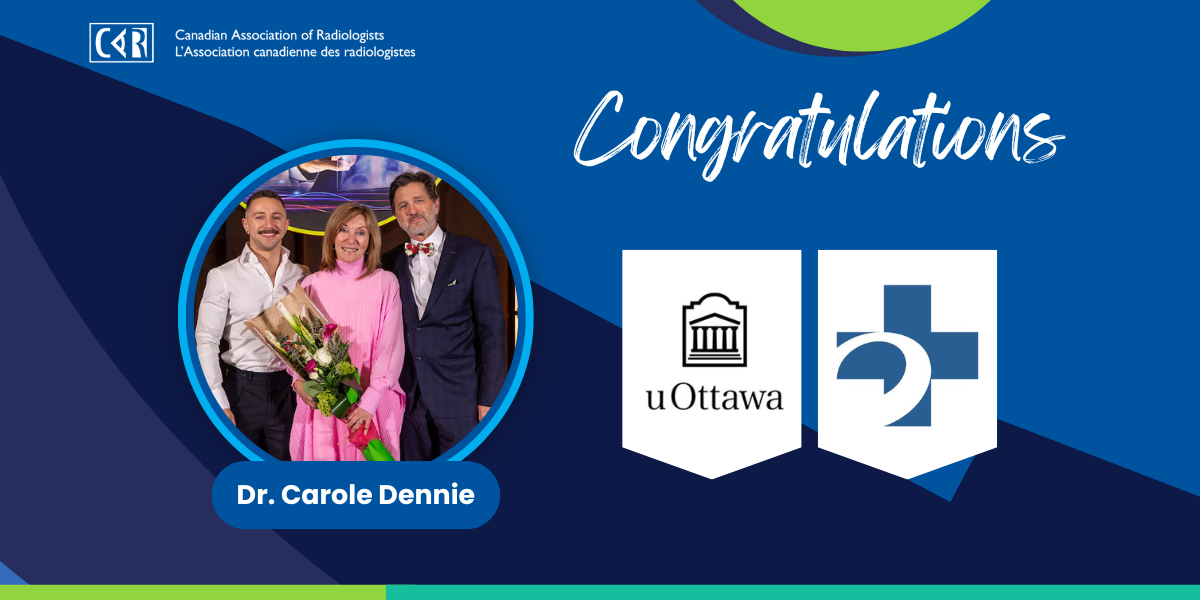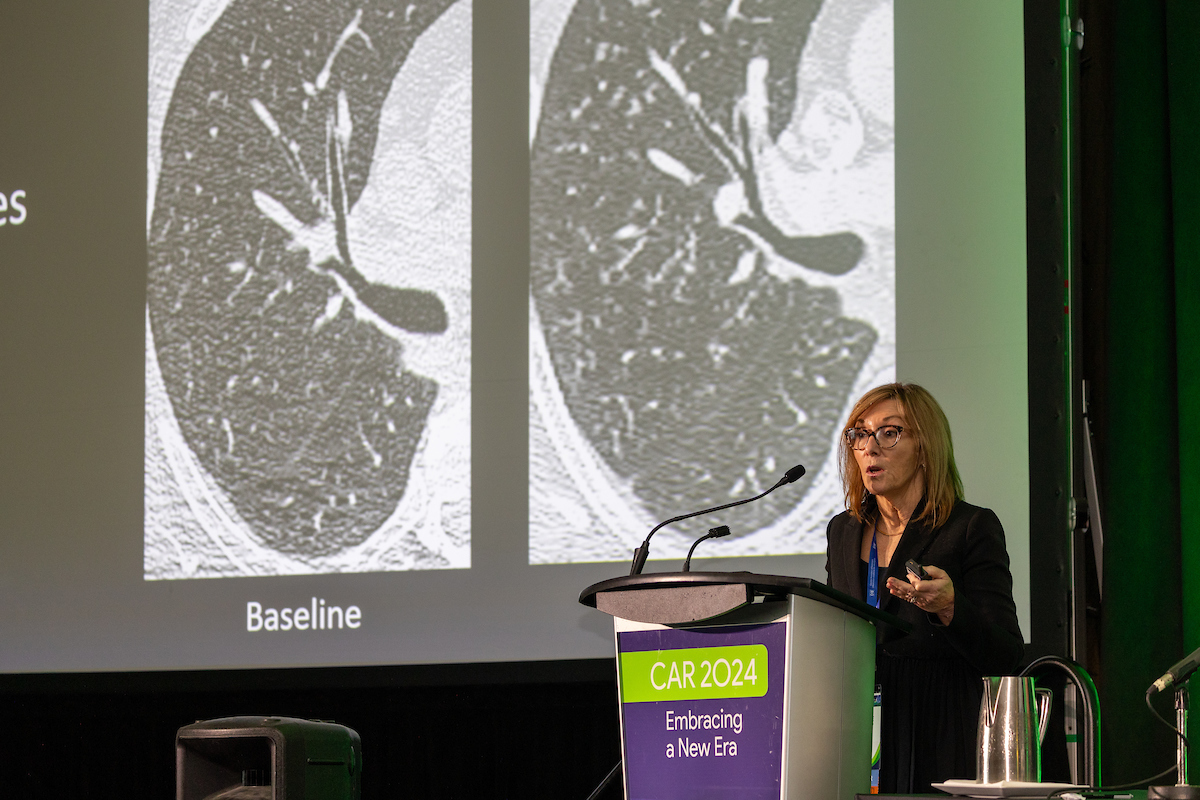The CAR is thrilled to congratulate Dr. Carole Dennie on recently being appointed Chair of the University of Ottawa Department of Radiology, Radiation Oncology, and Medical Physics and Head of The Ottawa Hospital (TOH) Department of Medical Imaging.

Dr. Dennie says she is grateful to take on this responsibility.
“I have worked in Ottawa since I finished my fellowship and have grown up in a wonderful department supported by The Ottawa Hospital and the University of Ottawa. They have enabled my career to flourish. With this appointment, I have been given the permission to finally give back to my colleagues and to the institution.”
Having spent the last year as Interim Head and Chair, Dr. Dennie has gained critical insight into the challenges and tremendous potential of the people in radiology in Ottawa and surrounding area.
“My first goal is to enrich the quality of care for patients.”
Like the rest of Canada, hospitals in Ottawa have seen the volume of imaging dramatically increase over the past several years. The increase in demand has, in part, led to a relative shortage of radiologists, says Dr. Dennie.
“At TOH over the past six months, with the help of many in the department, we have successfully recruited nine subspecialty radiologists – the largest net new increase in years. This will enable us to provide better care and a better patient experience through more rapid report turnaround time and will eventually improve coverage in our Emergency Department.”
She also aims to find new ways to create more access to imaging for all patients.
“I am committed to working with our regional partner hospitals and potentially develop new partnerships so patients can be imaged closer to home and in a timelier fashion, all with the aim to provide the best possible experience and tertiary care needed.”
“My second goal is to ignite the power of people.”
“Over the last year, I really strived to foster a culture of respect and inclusivity,” says Dr. Dennie. “This is key to our success as a department, but it will take time. I’ve also strived to strengthen the relationship between our physician leaders and hospital administration.”
Cultivating these relationships is important, she notes, and goes a long way when articulating the need for additional resources for CT or MRI and improved access to image-guided biopsies for cancer patients.
“Lastly, the TOH Department of Radiology’s governance dates to the late 1990s. I will help create a new governance structure by collaborating with a group of thoughtful, positive-thinking radiologists in our department with help from the university and the hospital.”
Engaging and empowering these radiologists, Dr. Dennie says, will ensure success as an academic department in the future and create leaders of tomorrow.
“My third goal is to nurture our social responsibility.”
Dr. Dennie aims to accomplish this by expanding the global outreach of the department through education and partnerships with non-profit organizations and other established programs at the Faculty of Medicine.
“This year, I recruited a department member into the Clinical Global Health Council at the university, and we also started a Rad-Aid International Chapter. Rad-Aid is a non-profit organization that invests in education to improve and optimize access to medical imaging in low-resource regions of the world.”
Additionally, Dr. Dennie hopes to maintain her prosperous relationship with the Vice-Dean of Internationalization and Global Health for the Faculty of Medicine, working to strengthen their impact on and recruitment of learners in the Middle East region.
Nurturing social responsibility also extends to the environment, says Dr. Dennie, who plans to decrease the department’s environmental footprint. She explains there are many opportunities to make a difference.
“Radiology is a top contributor to the healthcare carbon footprint due to high energy-consuming devices and waste from interventional procedures. This is especially important in our aging infrastructure and there are relatively easy ways to make a significant impact. I’d like to purchase from vendors who produce scanners that use less energy, like machines that use passive cooling systems to reduce the need for powered cooling systems or use AI to track power consumption. I will also be upgrading rather than replacing equipment when feasible and will work to incorporate appropriate use and clinical decision support tools to reduce low-value imaging, among many other examples.”

“My last strategic goal is to accelerate discovery.”
The department has a strong history of supporting research, says Dr. Dennie, and she wants to increase this support moving forward by making enhancements to her staff.
“One avenue I’d like to pursue is to create a Chair of Research position to enrich our support even further. I also want to recruit a Director of Information Technology to leverage AI tools. Diagnostic Medical Imaging is poised to take advantage of AI to ignite research that will improve workflow, and ultimately patient care and outcomes. One of the many ways we can approach this is by working with our Chief Information Officer and his team at TOH to ensure we have a thoughtful approach to industry partnerships.”
Dr. Dennie notes that while the department has a strong culture of education, it lacks a Chair of Education position, which she will create.
“I’m also excited to work with the leadership at the University of Ottawa to develop innovative ways of teaching the learners of today. One way of doing this is by working with equipment vendors to install CT in our simulation center where we could train technologists without impacting our daily workflow, train residents and fellows to do CT-guided procedures using simulation methods while using this equipment to address imaging wait times during the evenings and weekends.”
Moving forward, Dr. Dennie aims to work with the Director of Imaging to train advanced technologists to act as physician extenders within the department.
“Lastly, I want to further Francophonie at the University of Ottawa,” she says, “by reaching out to our French speaking hospital partners to provide community electives for our residents.”
Facing Challenges Along the Way
Dr. Dennie knows there are challenges posed by each of her goals, which she says are shared across the Canadian medical landscape. Staffing and equipment are consistent pain points.
“The most significant challenges we face is excessive imaging wait times due to lack of sufficient imaging equipment and aging equipment. More recent concerns are the acute shortage of radiologists to deal with increasing demand and how to recruit and retain radiologists in academic practice.”
Learning how to incorporate AI into workflow processes is also critical, says Dr. Dennie.
“We need to figure out how best to leverage AI to improve our workflow. I look forward to working with the Chairs of Academic Radiology (CHAR) and the CAR to help me navigate these challenging issues.”
Congratulations once again to Dr. Dennie on this major career milestone.
